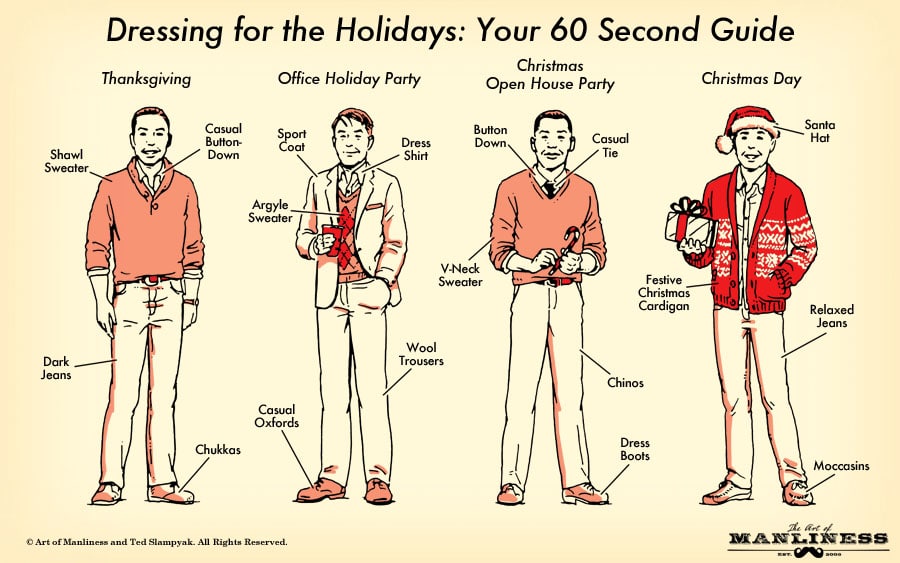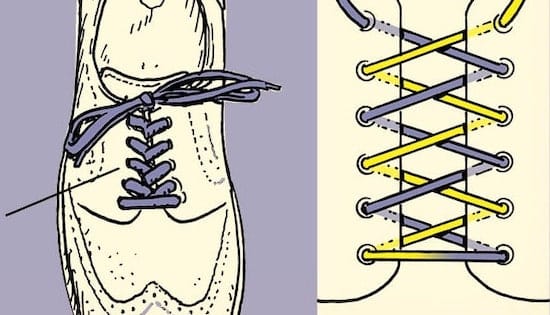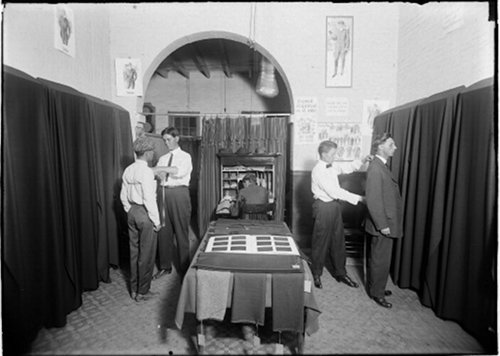
For most of human history, recreational swimming was done naked. Our 26th president, Teddy Roosevelt himself, often took nude plunges into the Potomac. And men’s high school and college swim teams would even train in the nude well into the 20th century.

Men’s swimsuits of the past were modest, full-body deals, that could be knitted for you by Aunt Myrtle.
Outside of all-male groups, men were expected to cover up. Clothing that one wore specifically for swimming was firstly a modesty garment, and a practical garment second. Swimsuit regulations were the strictest in the U.S. in the late 19th and early 20th centuries, when men were prohibited by law and custom from going bare-chested in public. Woolen one-piece suits with cutoff sleeves and legs were the common style. In the 30s, that began to change, and men actually organized protests arguing for the right to go topless, many of whom were cited for public indecency. Finally, in 1936, the topless ban was lifted in Westchester, New York, and other cities and states followed suit (no pun intended!), mostly for economic reasons.
From that point on, swimsuits were more about function and style than modesty. Specialty suits began to evolve in the ’60s and onward, leading up to today’s world of wetsuits, boardshorts, drag suits for training, and more.
Modern Styles
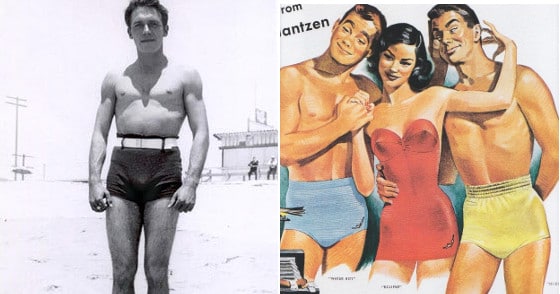
The length of men’s swim shorts have risen and fallen over the years. Long shorts have been popular for the last couple of decades, but shorter trunks (though not this short!) are coming back into style.
Contemporary swimsuits can serve both decorative and practical functions; most strive for both. Swimsuits are usually categorized by the length and looseness of their cut.

These are both swim trunks, but obviously look very different because of color choice and inseam.
- Trunks are the most common men’s swimwear in North America. They look similar to shorts worn as clothing on land, but are made from light, fast-drying materials (usually nylon or polyester) and feature a tighter-fitting lining inside the shorts. Colors and inseam lengths can vary widely.
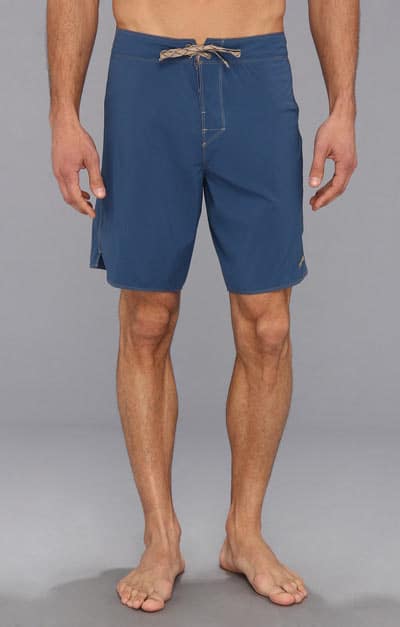
Boardshorts — a subset of swim trunks.
- Boardshorts are a longer version of trunks that come to or past the knee. They often have a non-elastic waist and fit closer to the torso. Originally developed for “board sports” (surfing, paddleboarding, etc.) they were designed to have less material that could catch as you mounted your board.

- Swim briefs are often called “speedos,” a trademarked brand that has been popular for many years. They are tight, body-hugging swimsuits with a V-shaped front that bares the thighs. Recreational swim briefs typically feature an interior lining. Briefs are much more popular in Europe than North America.
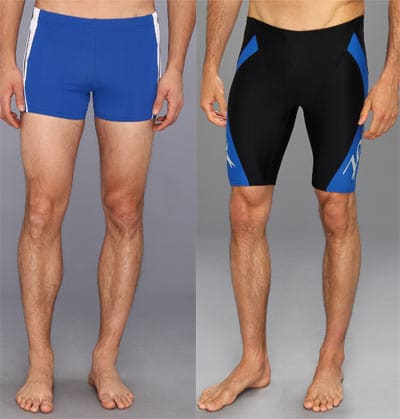
Square-cut shorts on the left; jammers on the right.
- Square-cut shorts are a body-hugging style that covers the wearer from the waist to the upper thigh. The leg openings are cut straight across for a boxy look that is slightly less revealing than angled swim briefs.
- Jammers are knee-length, skintight suits used by competitive swimmers and other water sports athletes to reduce drag. They resemble bike shorts, but without the padded crotch and seat.
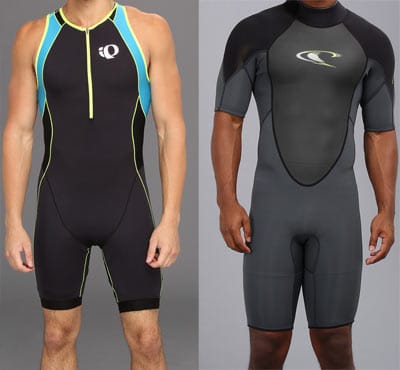
- Wetsuits and drysuits are insulated suits designed for prolonged immersion, usually in the context of snorkeling, scuba diving, or board sports. They are quite close-fitting.
- Rash guards are a looser form of all-body swimwear than a wetsuit, and are generally used by water sports participants such as surfers, kayakers, and paddleboarders. Most are made from a UV-reflective fabric with a UPF rating.
- Swim shirts are an upper-body-only version of a rash guard, and are gaining popularity as a sun and surf protection option for casual bathers.
All of the above styles can come in nearly any color or pattern imaginable, provided one is willing to shop around long enough. Traditional colors and patterns for men include solid navy blue, blue-and-white striping, and floral or Hawaiian-style prints.
Buying a Swimsuit
Swimsuits are, relative to a lot of menswear, forgiving garments to shop for. You don’t need an absolutely perfect tailored fit, so long as the suit stays up when you dive in (and most have a cord at the waist to help with that).
That said, you shouldn’t just grab whatever is cheapest off the Walmart shelf and call it a day. You are likely to only have one or two swim garments in your wardrobe at a time, so it’s worth finding ones you really like.
A few key steps to doing so:
1. Know Your Active Needs
Just how intense are your activities going to be in your swimwear?
A swimsuit for a hotel pool now and then doesn’t have a lot of technical requirements. Something to go surfing in for hours at a stretch is another matter.
Think about the following when you’re weighing swimsuit options:
- How much leg movement are you going to do? Loose fabric, when wet, can chafe very quickly, so a loose trunk style of shorts isn’t great if you plan on walking around in your suit or using your legs for exercise. (Despite their name, boardshorts aren’t often used by athletes these days; pro surfers usually wear snug, tight-fitting swimwear.)
- How much actual swimming (as opposed to wading and splashing around) are you going to do? You’ll want to reduce drag if you’re actually propelling yourself through the water for any length of time, making a tighter fit preferable. The square-cut shorts below are a solid option for a fit, shorter man who loves to swim as well as lay out in the sun!
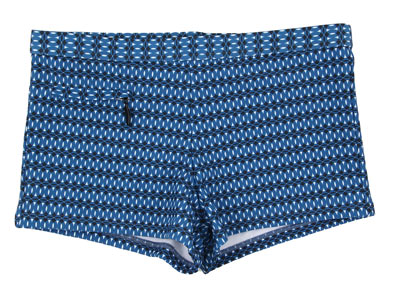
- How much sun protection do you need? For prolonged sun exposure, it’s worth considering something that covers the upper body as well as the lower.
As you can see, the basic, short-like trunk style is really only suited for casual users who plan on lying around, wading, and maybe doing a little light swimming. If you’re planning on being more sporty than that, a snugger fit and potentially some more body coverage is worth considering.
2. Know the Visual Impression You Want
Thinking about who you’re going to be wearing your swimsuit around is just as important as thinking about your activity levels.
Family vacationers don’t have much in the way of stylistic needs. Men who are planning on hitting up beach parties and crowd scenes need to be a little pickier. And businessmen who may end up in the spa or hotel pool with co-workers and business partners have their own special concerns. Ask yourself:
- Are you trying to impress anyone? If not, stop worrying. Wear whatever is comfortable and works for you.
- Are you trying to look professional? Conservative (but not exaggerated) length, conventional styles (trunks or square-cuts), and dark, solid colors or restrained stripes are for you. Navy blue with brass-colored grommets and white rope ties are always safe.
- Do you want to look as good as you can? If so, you’ll need a cut that flatters your body type (see below), and a color and pattern that’s eye-catching without being ridiculous. Think stripes, plaids, bright solids, or some not-too-crazy floral patterning. Larger men should avoid close-cut styles like board shorts, despite them being in fashion.
These questions will affect the color, patterning, and cut you decide to go with. Tight, form-fitting styles look sharp and practical in the longer cuts, but sexualized and only good for showing off your body in the smaller cuts. Baggier styles look less sexualized, but can also look slumped and casual, which may or may not be what you’re going for.

Simple trunks like these will work in a wide range of settings — from the beach to eating afterwards at the cafe.

Some trunks like these are even specifically made to be worn all day — they dry quick, have pockets, and are styled like everyday shorts, making them especially versatile for days where you don’t know when you’ll be swimming, or will be getting in and out of the water between other activities.
3. Be Honest About Your Body
It’s the 21st century — if you want to let it all hang out, you’re free to, at least as far as the local laws permit.
That said, some realistic expectations about who wants to see your naked flesh, and how much of it, go a long way. A little self-consciousness is not a bad thing. Ask yourself a few questions regarding your body:
- Are you a little soft around the middle? Two schools of thoughts here:
- For the modest man, trunks are your best option. A looser cut will balance things out. Avoid boardshorts or a strongly-elasticized pair of trunks that dig in to your belly. Also stay away from longer inseams, as they’ll pull your trunks down when you walk. Look for a shorter cut in a non-attention-grabbing color.
- For the confident large man who prizes comfort, consider swim briefs. Yes, many of you might think this is a sight others don’t want to see, but realistically this will be the most comfortable option physically. They don’t slip down and will conform to your body. Mentally, though, are you confident enough to let it all hang out? I’ve been to European beaches — over there swim briefs are not a big deal. Stateside, you’ll need a bit more confidence.
- Are your thighs and buttocks toned? If they’re not, a tight swimming brief is going to expose a lot of jiggle. Your call on whether you want to do that or not.
- Are you fit, but a bit more modest? Longer, form-fitting styles like jammers or wetsuits are for you — all the streamlining and none of the naked flesh. If you’re proud of your six-pack abs, board shorts will show them off to full effect.
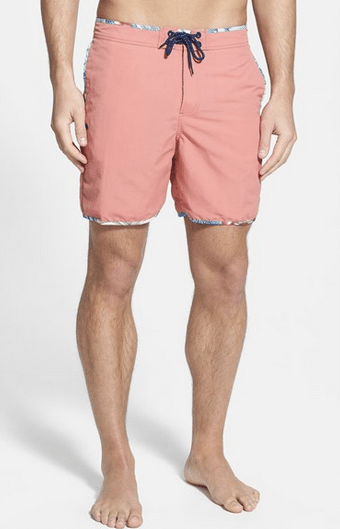
For a good compromise between very long trunks and a short square-cut suit, look for shorts with a 6-7 inseam. This length has been coming into style of late. Brett in fact recently traded his self-described Hawaiian “suburban dad” shorts for this pair.
In general, my advice is to default to trunks, and depending on a specific need or desire, pick up a second pair in a style you feel best suits your needs.
Oh — and make sure you know how to swim. No swimsuit can save you from drowning. Well, except for maybe this one:
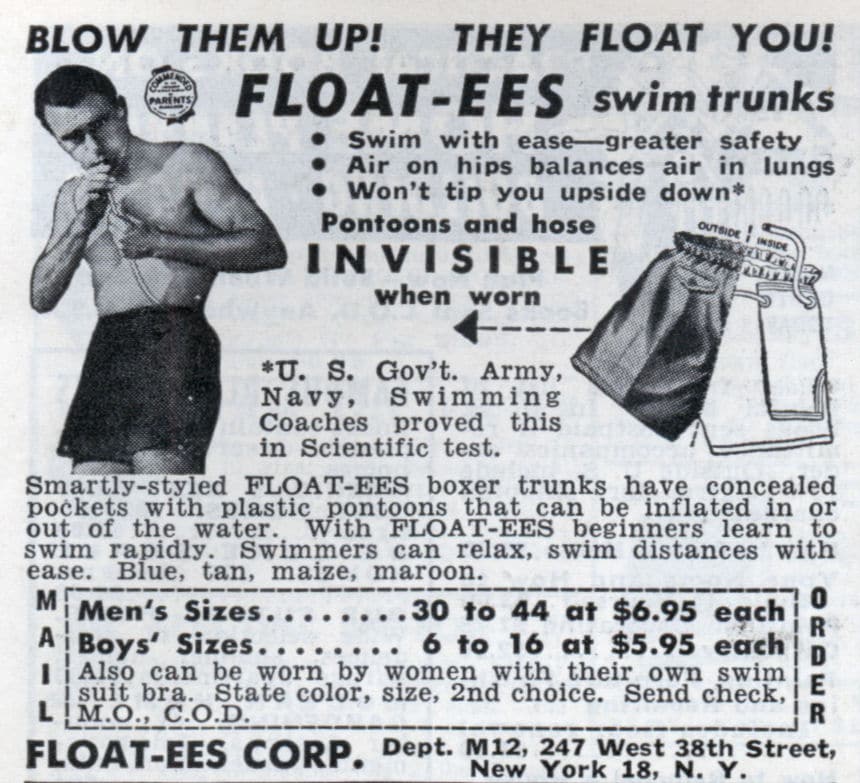
Watch the Video
Written By:
Antonio Centeno
Creator of The Style System, A 5-Week Professional Presentation Course



